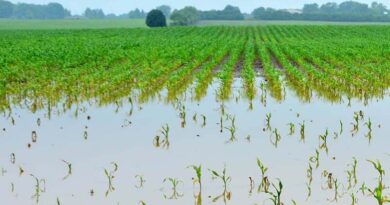Crop limitations in a water-deprived environment
19 September 2021, US: I distinctly recall sitting in a room in the John Mitchell Building for my first soil fertility class. The professor walked in and said, “Just remember – the most limiting nutrient in crop production in Saskatchewan is WATER!” as he scrawled H20 under the heading “Key Nutrients.”
Crop limitations in a water-deprived environment.
This year is going to go down as “one of the big ones” and will be referenced along with those asking, “Remember 1961?” or exclaiming, “it was so dry in ’88!” The challenges faced in 2021 will be added to this extensive line of years to remember on the Canadian Prairies and Northern Plains. In the next few blogs, I will analyze drought from three perspectives. For today’s blog, I will start by taking a wider perspective on droughts and climate change. In the subsequent blogs, I will review the impact of drought on soil fertility and pest control.
Also Read: Escorts Limited and IndusInd Bank come together to serve the farming community
Each crop has what is called a Water Use Efficiency or Moisture Use Efficiency. Water Use Efficiency (WUE) of a plant is defined as the amount of dry matter produced by a plant for a given amount of water. However, we usually think of it as the amount of grain produced by a given amount of water. Crop types differ in their WUE, and the timing of moisture stress on a crop has a significant impact on end yield. The most crucial period of development where moisture stress can impact yield is during reproductive growth. Indeterminate crops such as wheat, barley and oats flowering will occur over a brief time, meaning a short duration of moisture stress can be very detrimental. Indeterminate crops such as canola or pulses flower over a longer period and may be able to recover some yield if favourable conditions return after short-term moisture stress.
The following table shows the Moisture Use Efficiencies across four crops – CWRS Wheat, Barley, Oats and Canola. The table was initially prepared in the late 1980s before the adoption of no-till. No-till has been shown to improve the WUEs of crops on the Canadian Prairies. The table does not reflect genetic improvements made in the last 30 years – especially with the introduction of hybrid canola.
Moisture Use Efficiencies of Major Crops in Major Soil Zones of the Canadian Prairies:

What the table does show is that crops are more efficient with water under cooler, moister conditions, as represented as we move from Brown through Dark Brown, Black and to the Gray soils. Drought is not new for prairie and plains farmers. Tracing back using tree rings and other observations, there was a drought that lasted about 100 years, with an approximate start date of 1482, when droughts started to be routinely recorded. Of course, the drought during the 1930s is legendary and commonly known as “The Dirty Thirties” because of the soil erosion and the clouds of dust that resulted. Nine of the 11 years from 1929 to 1939 inclusive were drought years. This corresponded with an economic depression that resulted in a tectonic shift in the social, economic, and political dynamics of the region. In addition, it started a major revolution in the way agriculture was practiced in north-western North America.
Since the ‘30s, there have been several memorable droughts.
The most notable of these have a couple of things in common. The most notable droughts such as 1961, 1988 and 2002 followed dry years. The other common theme among these three droughts is that the summers of 1961, 1988 and 2002 were also very hot. Although I was just a young lad in 1961, I remember how hot it was and how the harvest was wrapped up by my birthday on August 25th. If the above sounds familiar, it’s because this is taking place right now. We have endured dryer than normal conditions for, depending on where you are, the last 3-4 years and 2021 has been exceptionally hot. In the 1980s, there were several drier than normal years, but it wasn’t until the abnormally hot years of 1988 and 1989 that the drought caused issues. There are 2 types of drought – hot season droughts were significantly lower than normal precipitation is accompanied by above-normal temperatures and cool-season droughts, where significantly lower than normal precipitation is accompanied by average or below-average temperatures. Hot droughts are significantly more destructive than the cool season droughts.
The drought of 1987-89 also caused a tectonic shift which resulted in the development of “conservation farming” or “no-till or min-till”. The corresponding development of no-till seeding technologies, fertilizer placement and the introduction of cheap and effective herbicides in the late 80’s reduced the economic penalty of reduced tillage and in fact, showing increased profitability at the end of the year. The adoption of no-till technology since the 1990s has been one of the most remarkable changes that have revolutionized the crop production system in Canada, especially in the Canadian Prairies. In the Prairies, in 1991, only 7% of producers used no-till to prepared land for seeding. Between 1991 and 1996, the use of no-till more than doubled with about 16% of producers using no-till in their farming operations. By 2001, the use of no-till doubled again to 31%. In 2006 half the farmers in western Canada were using no-till and 76% were using reduced tillage or no-till practices.
The use of reduced tillage practices dramatically diminished the impact of the 2001-2002 drought. While still devastating yields, soil erosion was significantly reduced and, in many areas, farmers reported 30%-50% of a normal crop whereas in 1988-89 they got nothing under similar conditions.
What has changed in 2020-21?
It appears that we got sloppy with our soil and water conservation practices. I am seeing a lot more tillage, particularly in the Black soil zones in the last 10 years. This is likely a result of having farmed through five of the wettest years on record (2010 – 2014) and having changed practices, especially concerning tillage and fertilizer practices. Many growers now use Vertical Tillage equipment. While this equipment does have a fit, especially for repairing rutted fields and drying out wet fields, they also dry out dry fields. The dry winds that we have experienced for the last three years will dry the soil out to the depth of tillage. And every inch of soil moisture lost is an inch you will wish you had come June! I have often heard Les Henry – Soil Moisture Guru state “moisture in the soil is like money in the bank.” Heed this statement and do whatever you can to increase storage of winter snow and reduce losses due to tillage! Roughly speaking, a foot of soil moisture equates to an inch of rain.
Review your practices this fall:
- Try and cut your stubble as high as possible. The taller the stubble, the larger the snow trap potential. Remember – a foot of snow is equal to an inch of rain.
- Park your Vertical Tillage equipment. They do too good of a job drying out the soil.
- If you must, harrow in the least aggressive settings to preserve the stubble.
- If you apply fall fertilizer, use narrow knives to apply anhydrous ammonia or urea. More on that next blog.















